Growing cucumbers is fun, and they are very prolific when given the proper care. In this post, I’ll teach you all you need to know to have the best success.
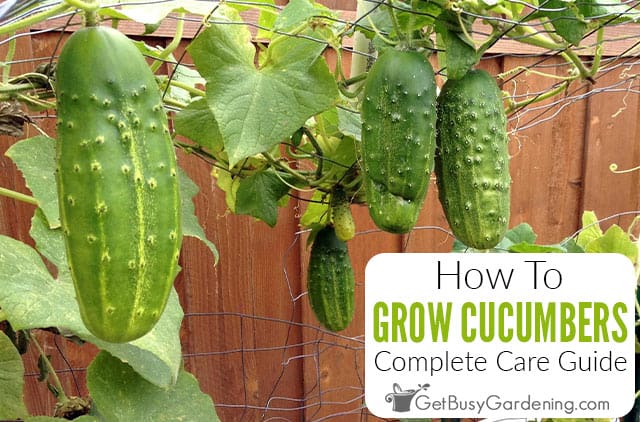
Fast-growing cucumber vines are a wonderful addition to any backyard vegetable patch, and they are a staple for many gardeners.
Once you know how to grow cucumbers and keep them thriving, even beginners can enjoy a wonderful crop.
From sunlight to watering, fertilizing, and soil, below I’ve shared all the information you’ll need to enjoy the biggest yields and best flavor.
Quick Cucumber Care Overview
| Scientific name: | Cucurbits |
| Classification: | Vegetable |
| Common names: | Cucumber |
| Hardiness: | Annual |
| Temperature: | 60-95°F |
| Flowers: | Yellow, blooms summer-frost |
| Light: | Full sun to partial shade |
| Water: | Keep evenly moist |
| Humidity: | Average |
| Fertilizer: | Balanced, or slightly higher in phosphorus |
| Soil: | Rich, fertile, well-draining |
| Common pests: | Cucumber beetles, aphids, slugs, cutworms |
Information About Growing Cucumbers
Cucumbers are cucurbits, or from the Cucurbitaceae family. You may know these annuals as part of the gourd family, which also includes other garden favorites like squash and melons.
They’re natively a tropical, warm-weather fruit from India, but now they’re grown and enjoyed worldwide. And, despite the technical classification, they’re more commonly known as a vegetable.
Long vining types get between 3-12’ tall, while the compact bush varieties tend to stay under 3’. Both feature central stems, large green leaves, and flowers that develop crisp, firm cucumbers.
Different Types Of Cucumbers
There are dozens of cucumber varieties, from heirlooms to hybrids, and each have unique qualities. The easiest way for home gardeners to choose is to consider where you’ll grow them, and how you’ll use them.
- Slicing – These types are known for their fresh, crisp bite. They often have thin skin and grow in the traditional cylindrical shape. English, Persian, and Sweet Slice are just a few varieties.
- Pickling – To make your own pickles, these are the best options. They contain less water and are smaller. Carolina, Homemade Pickles, and Sumter cucumbers are popular types.
- Burpless – These varieties are grown to have less cucurbitacin, the compound that causes bitterness and burping. They’re usually seedless, thinner, and easier to digest. Try Muncher, Baby Persian, or Marketmore.
- Bush – These grow in a compact shape, making them ideal for containers and small spaces. Bush Champion, Salad Bush, and Spacemaster are all popular types.
Vining vs Bush Cucumbers
At a very high level, there are two different types of cucumber plants: vining and bush.
Most varieties are climbing vines. The vast diversity and generally higher yields make them a popular choice for home gardens.
On the other hand, bush types are far more compact, and don’t vine out. They’re great for small spaces, and do very well in containers.
They don’t produce as much, but you can make up for that by growing more than one.
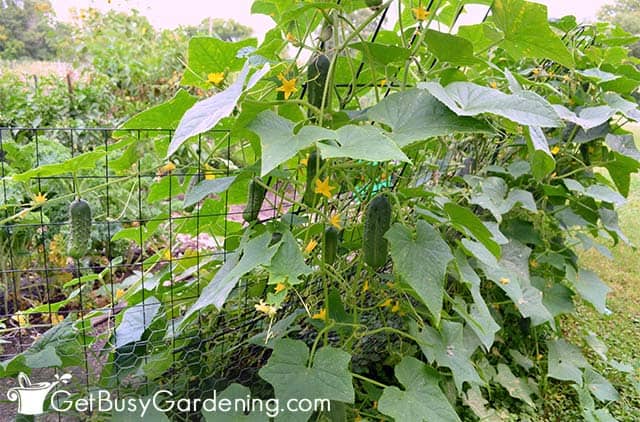
How Do Cucumbers Grow?
To be pollinated, cucumbers need both a male and a female flower open at the same time.
They’re the same color and look very similar at first glance. But the males have a long, thin stem, while the females have a tiny baby fruit at the base of the flower.
If pollinated by the males, the small cucumber on the female flower will begin to grow larger. If not, they’ll turn yellow and drop off the plant.
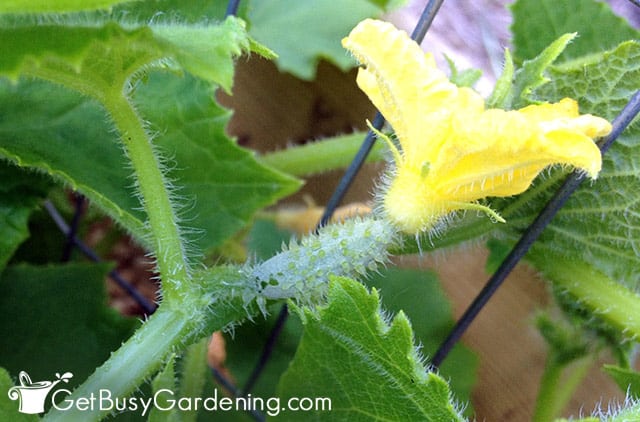
How To Grow Cucumbers
Before we get into the details of cucumber care, first we need to discuss timing and location. Choosing a good spot at the right time of year can make a big difference in your success.
Where To Grow Cucumbers
When it comes to location, you have lots of options. You can grow cucumbers in raised beds, garden plots, or even containers.
They’re a warm weather plant that will prefer full sun, but many can still thrive and produce in partial shade too.
If you’re growing vining types, be sure to get the support set up early. For containers, you’ll have best success with bush varieties.
When To Plant Cucumbers
When all chance of frost has passed in the spring, or about 2-3 weeks after your last frost, you can begin planting outdoors.
Use a soil thermometer to make sure it has warmed up above 50°F to ensure you get the timing right.
How To Plant Cucumbers
The best way to plant cucumbers is to sow the seeds directly into your garden once all change of frost has passed in the spring.
If you prefer to start them indoors earlier, then make sure to use plantable pots. Otherwise, disturbing the roots while transplanting them can stunt their growth. Learn exactly how to plant the seeds here.
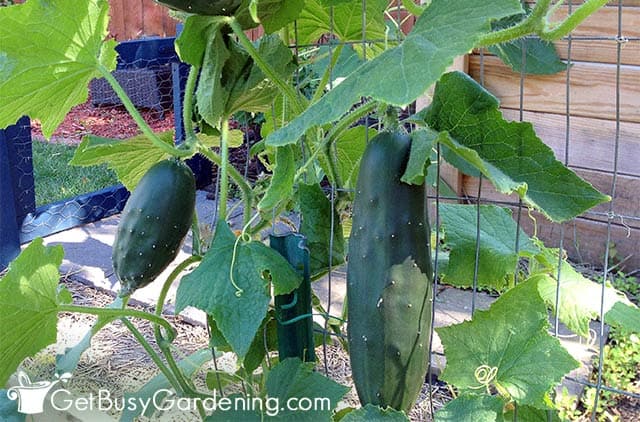
Cucumber Plant Care & Growing Instructions
Now that you know where, when, and how to plant them, it’s time to talk about how to grow your cucumbers. Giving them the right care is essential for success.
Sunlight
Cucumber plants will produce the best with 6-8 hours of direct sun per day. But if that’s not an option, they can still produce in partial or even full shade.
A general rule of thumb is the less sun they get, the less fruit they’ll yield. If possible, aim for at least morning sunlight. That will help keep dew and moisture off the vines.
Water
Water is a key part of growing cucumbers, they’re thirsty plants. It’s important to keep the soil evenly moist throughout the season, or they may not give you much.
The more sun they get, and the hotter it is, the more water they’ll need, so check on them often. If the soil is dry to 1” down, it’s time to water.
A moisture gauge can help make sure they’re getting the perfect amount.
Drip irrigation systems or soaker hoses are also useful to save you time, while making sure your cucumber plant gets plenty to drink.
Temperature
Temperature is very important for growing cucumbers too. They’ll thrive in daytime ranges between 60-95°F.
When it gets cooler than 50°F at night, or there’s any frost, they will suffer and stop growing.
In high heat, mulch around the stem to keep them cool. Water more frequently as well, or fruits may not set.
Related Post: How To Freeze Cucumbers The Right Way
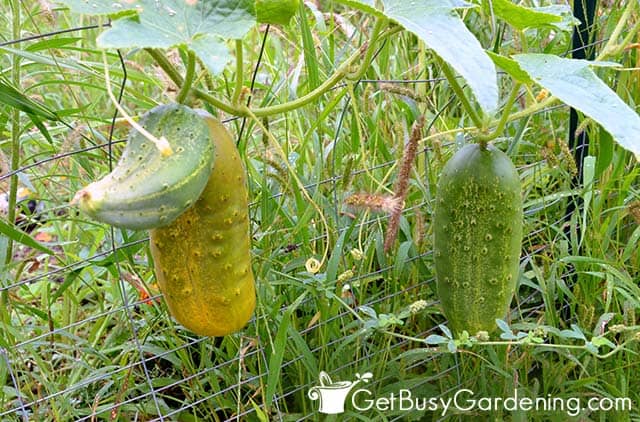
Fertilizer
Feed your vines and they’ll give you yummier cucumbers. It’s a good idea to add compost or worm castings to the soil, and to begin fertilizing when they start to flower.
Choose an organic formula made for flowering vegetables, either as a liquid or use slow release granules.
Opt for something that’s balanced, or slightly higher in phosphorus. Too much nitrogen will produce tons of leaves, but not many flowers. Apply water soluble types every two weeks, and granules once a month.
Soil
Rich, fertile soils are the best option for cucumbers. I recommend amending poor quality garden soil with compost or aged manure to help get them started on the right foot. I also like to add a granular fertilizer while planting.
Make sure the bed is free of any rocks, sticks or debris. Use a pH gauge to check that it’s between 6-6.8, and add some garden lime to neutralize highly acidic soils if necessary.
Trellising
If you’re growing vining cucumbers, then I highly recommend using a trellis to keep them off the ground. This will prevent them from taking over the garden.
It also helps to prevent disease and pests. Plus the cucumbers will grow straighter, be cleaner, and are also much easier to find.
Related Post: 13 DIY Cucumber Trellis Ideas For Small Or Large Spaces
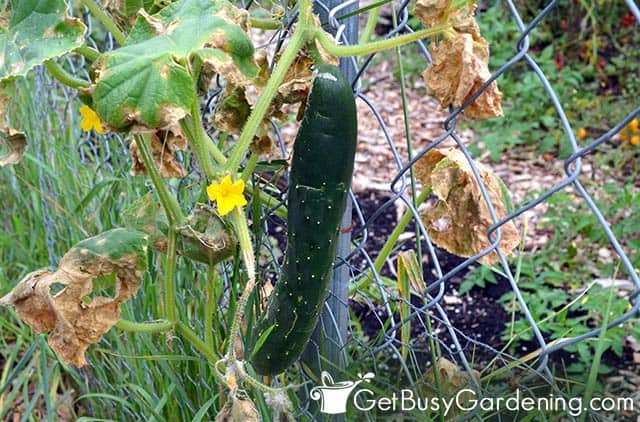
Pruning
Though not required, you can prune your cucumbers to help keep the plant a more manageable size, and refocus its energy on flower and fruit production.
As the main stem grows, be on the lookout for runners, or shoots coming off the sides near the base.
Prune them with sharp sterile shears when they’re less than 2” long. This will help the vines learn to grow tall, and keep the fruits off the ground.
It’s also a good idea to trim off damaged or diseased leaves as they appear, to help slow the spread, and keep them healthier.
Pest Control Tips
Unfortunately, we’re not the only ones who love to eat fresh cucumbers. Squash bugs, cucumber beetles, aphids, slugs, and cutworms can damage the foliage, vines, or fruit, and transmit diseases.
Hand pick any large insects, and check the underside of the leaves to destroy their eggs. Using an organic insecticidal soap or neem oil on the leaves are natural, useful ways to control bugs.
Diatomaceous earth can help deter or kill slugs and beetles, while aphids can be sprayed off with a sharp stream of water.
Row covers can also be useful for young seedlings. They’ll protect from bugs, as well as animals like rabbits or mice. But make sure to remove them when the first blooms start opening so the bees can get to them.
Disease Control Tips
One of the best things you can do to prevent disease on your cucumbers is to deter pests. In addition, trellising and adequate spacing are important to provide airflow between the foliage.
Proper watering is also essential. Be sure to keep the leaves dry. Splashing soil or sitting water on the leaves are the main ways that many diseases spread.
To slow the spread, you can use an organic fungicide, and regularly trim off any leaves that develop spots on them.
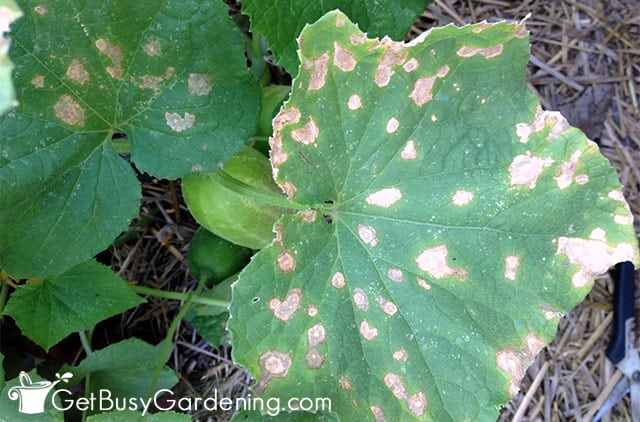
Tips For Harvesting
You should harvest when the fruits are small for the best flavor and texture. When left on the vine too long, they will become tough and seedy.
Pick them regularly to encourage the plant to keep producing. The more you harvest, the more you’ll get.
Once they start producing, the cucumbers will grow very fast. Check on them daily for new ones. Use precision clippers to remove them.
Pulling them off can damage the vine. Learn exactly when and how to pick them here.
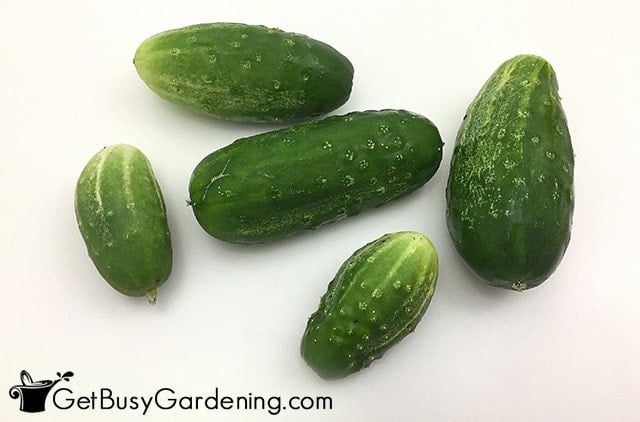
Troubleshooting Common Cucumber Care Problems
At some point during the growing season you may encounter an issue or two with your cucumbers. Be prepared to tackle them with these tips, and get them back in good health.
Leaves Turning Yellow
Bacterial wilt, insects, or mosaic virus could all be behind those yellowing leaves. You can try treating them with and organic fungicide, or trimming away diseased leaves.
But if it continues, remove the plants and destroy them before it can spread through the rest of your garden.
For bugs, hand pick them, treat them with insecticidal soap, or rinse them off will blasts of water from the hose.
Brown Spots On Leaves
When you see brown spotting on cucumber leaves it’s commonly caused by fungal or bacterial infections like Alternaria leaf blight, anthracnose, mosaic virus, or bacterial wilt.
It’s important to remove affected leaves or plants, or begin treatment right away. Preventive measures include, watering only at the roots to keep the foliage dry, and rotating your crops every year.
Bitter Flavor
Disease, overwatering, or overripe fruit can all be reasons that your cucumbers taste bitter.
Check the foliage for any signs of disease, and make sure the soil is not soggy or puddled with water.
You should also pick cucumbers as soon as they’re green and firm. Waiting too long will lead to large, yellowing fruit with a pronounced bitterness.
No Flowers
Cucumbers need sunlight, nutrient rich soil, and plenty of water to flower. Too much shade, cool temperatures, or depleted soil can be issues.
Using a phosphorus rich fertilizer can help encourage more flowers. Also make sure you’re not letting the soil dry out more than an inch between drinks.
Fruits Turning Yellow
When female flowers aren’t pollinated, the baby cucumbers will turn yellow and then drop off.
If larger fruits are turning color, it can be caused by overwatering, disease, lack of nutrients, or overripening. Learn more about all of the causes and how to fix them here.
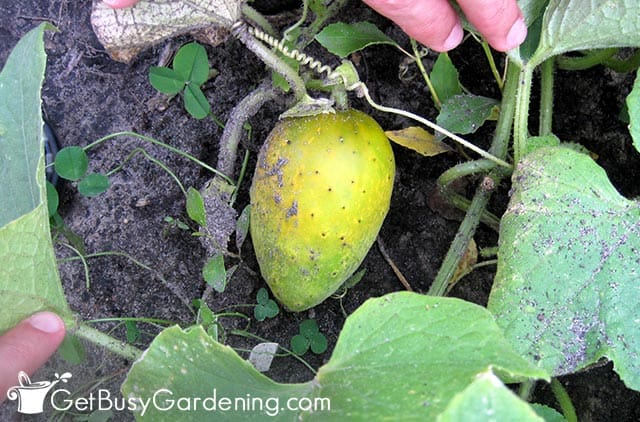
FAQs About Growing Cucumbers
I’ve answered several of the most frequently asked questions about growing cucumbers here. If yours isn’t listed, please add it to the comment section below.
How long does it take to grow cucumbers?
How long it takes to grow cucumbers depends on the variety and their care, but in general they are ready to harvest 50-70 days after germination.
How many cucumbers do you get from one plant?
How many cucumbers you’ll get from one plant depends largely on the variety, environment, and care.
Full sun, vining varieties with even moisture and rich soil will produce the most, while bush types naturally have a much lower yield.
Why are my cucumbers prickly?
Your cucumbers are prickly because of the variety you’re growing. Just as they differ in flavor, size, and shape, the outer rind can vary between bumped, ridged, and even prickly.
How do cucumbers grow best?
Cucumbers will grow best in full sun and fertile soil, with warm temperatures and plenty of water every week.
Is cucumber a fruit?
Yes, technically a cucumber is a fruit because they contain seeds and grow from a flower.
How much sun do cucumber plants need to grow?
How much sun a cucumber needs can vary. Ideally they should get between 6-8 hours for maximum production, but they can grow well with as little as 3-6 hours.
With these tips on growing cucumbers, you can tend to your plants and keep them healthy and productive. Even beginners can have great success once they learn the ins and outs of their care.
If you want to learn all about growing your crops vertically, then you need my book, Vertical Vegetables. It has everything you need to know to be successful, plus almost two dozen detailed step-by-step projects that you can build in your own garden! Order your copy today!
Learn more about my Vertical Vegetables book here.
Recipes Using Cucumbers
- How To Make Mustard Pickles (Recipe)
- How To Make Bread & Butter Pickles (With Recipe)
- Quick & Simple Old Fashioned Sweet Pickle Recipe
More About Vegetable Gardening
- How To Grow Cucamelons (Mouse Melon)
- How To Grow Zucchini
- How To Grow Potatoes
- How To Grow Garlic
- How To Grow Winter Squash
- How To Grow Brussels Sprouts
- How To Grow Peas
Share your tips for growing cucumbers in the comments section below.
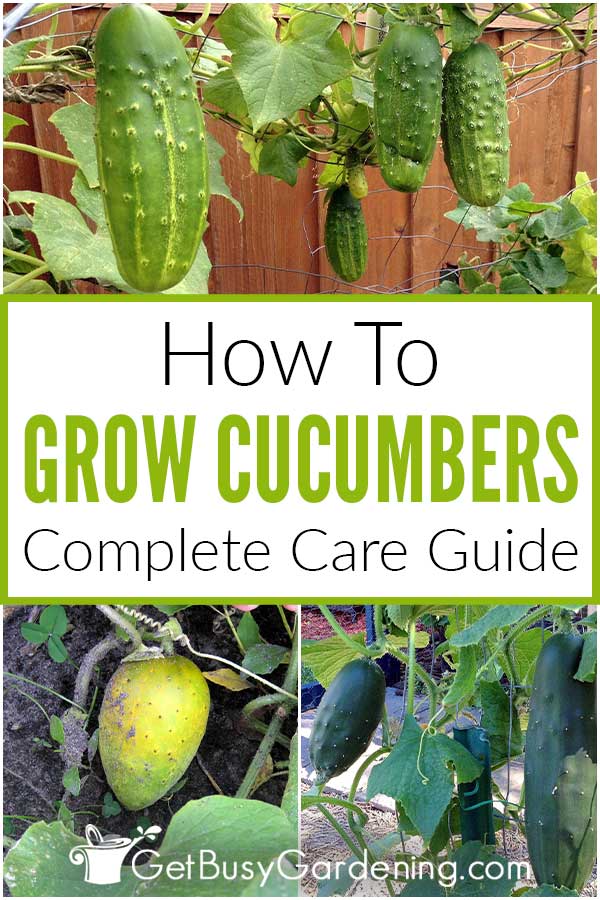





Sara says
I started cucumber seeds in 35 mm pellets last Tuesday. On Saturday they all sprouted ( they were in a very warm spot). I want to know if I could put them outdoors to get the sunlight they need so I don’t have to buy a grow light. Also do they need to be transplanted to bigger pots or they could just stay with the pellets until I plant them. Thanks for this amazing guidance!
Amy Andrychowicz says
You can move your cucumber seedlings outside as long as it’s warm enough. However, don’t put them directly into the sun, you need to acclimate them or they could burn. Here are the steps for how to harden them so they’ll survive the transition. If they have outgrown the pellets, then you could plant them (pellets and all) into larger pots. But I recommend using plantable pots for cucumber seedlings. They don’t like to be transplanted, and it could end up stunting their growth, so it’s best to plant the whole pot into the garden to prevent the roots from being disturbed.